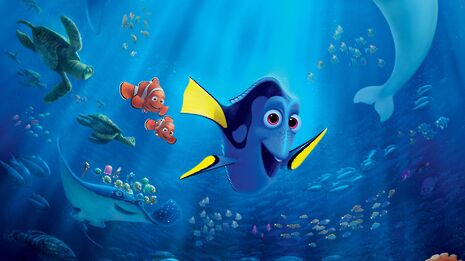Film: Finding Dory
Pixar’s latest release successfully appeals to both adults and children, evoking memories of its predecessor Finding Nemo and introducing entertaining new characters

Walking into a screening of any Disney or Pixar film, you will often find more than just children in the audience. I’m not talking about their begrudging parents, more excited by the prospect of a cup of coffee and a good opportunity for a nap than watching the film, nor the slightly creepy Disney die-hards, but the swaths of twenty-somethings who have no shame in buying a ticket. And nor should they. Finding Dory not only succeeds in capturing the imaginations of a new generation of children, but also allows those who were their age when Finding Nemo first showed to reminisce about the films of their childhood. Who knew an animation about a fish with memory loss could be so deep? (Pun very much intended)
This Pixar sequel to the colourful Academy Award-winning 2003 animation Finding Nemo tells the unexpectedly moving tale of everybody’s favourite amnesiac blue tang, the innocent and loveable Dory (Ellen DeGeneres) as she embarks on a journey to discover a past that she has long forgotten. With the help of companions old and new, Dory travels to the Marine Life Institute in California to find her parents, as her memories gradually begin to unravel.
As soon as the film began it was clear that Pixar had strived not only to allude to Finding Nemo, but also to create a whole new aquatic adventure. Certainly, I was initially concerned that the main purpose of the feature would be simply to satisfy fans craving more with constant, dragging references to the previous film; the first half sees the return of characters such as Crush and Mr. Ray, which generated knowing murmurs from the audience. I, however, rolled my eyes. Was this to be yet another trashy sequel designed only for commercial purposes? Nonetheless, the moment swiftly passed, and the plot continued swimmingly.
From this point, the film picked up significantly. Dory’s journey through the aquarium is delightfully entertaining. Whilst the introduction of new characters could easily have been a dull recreation of those in Finding Nemo, Pixar creates a fresh set of personalities that made the film funny throughout – the dim but loyal Becky and the sea lion duo (Idris Elba & Dominic West) were particularly amusing additions. Nevertheless, these characters are most significant due to their part in the story of Marlin and Nemo. Although this classic father-son relationship made Finding Nemo the heartwarming family film that it is, I found the re-emphasis of their ups and downs in this feature tiresome; the repetition of Marlin’s anxieties as a father that clash with his son’s desire for independence was unnecessary. But the pace of the plot was saved thanks to the new side characters they encounter and, more importantly, Dory’s own journey.
Perhaps the greatest success of the feature was the relationship between Dory and Hank, a cranky octopus who reluctantly helps her along the way. This pair captured my interest far more than the two clownfish. The amusing combination of Dory’s innocence with Hank’s pessimism resulted in an unlikely friendship similar to that in Up (2009). Dory spreads a kind of clueless joy everywhere she goes, eventually melting the iciness of Hank and allowing him to find his own freedom. Although the chase to find Dory’s parents was perhaps stretched out a little too long towards the end of the film, with false hope after false hope signalling the need for a bit more editing, my doubts did not last.
By the finale, I found that the build-up was well worth the wait, and there was clearly an emotional atmosphere in the audience, who were reminded of their own familial love and loss (even if this reminder was a family of fish). In spite of some excessive plotlines, Pixar has once again excelled in making an animated fantasy relatable on a personal level, this time by encouraging its viewers – young and old – to stay motivated and connected to their childhood, with the words: ‘What would Dory do?’
 News / SU reluctantly registers controversial women’s soc18 December 2025
News / SU reluctantly registers controversial women’s soc18 December 2025 Features / Should I stay or should I go? Cambridge students and alumni reflect on how their memories stay with them15 December 2025
Features / Should I stay or should I go? Cambridge students and alumni reflect on how their memories stay with them15 December 2025 News / Dons warn PM about Vet School closure16 December 2025
News / Dons warn PM about Vet School closure16 December 2025 News / Cambridge study finds students learn better with notes than AI13 December 2025
News / Cambridge study finds students learn better with notes than AI13 December 2025 News / CUP announces funding scheme for under-represented academics19 December 2025
News / CUP announces funding scheme for under-represented academics19 December 2025








